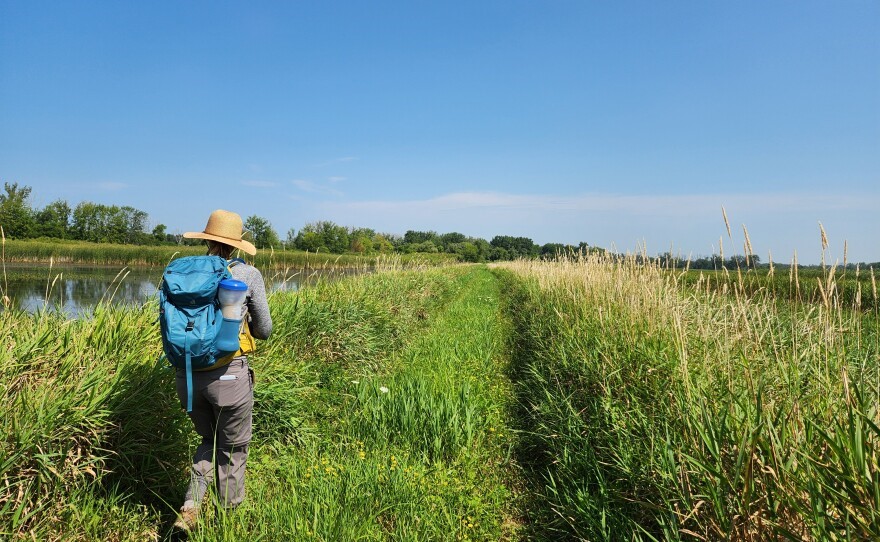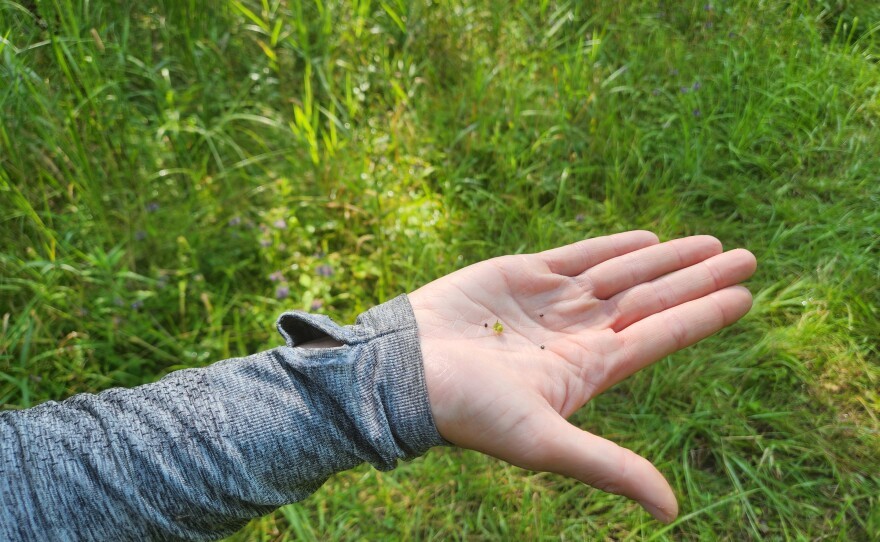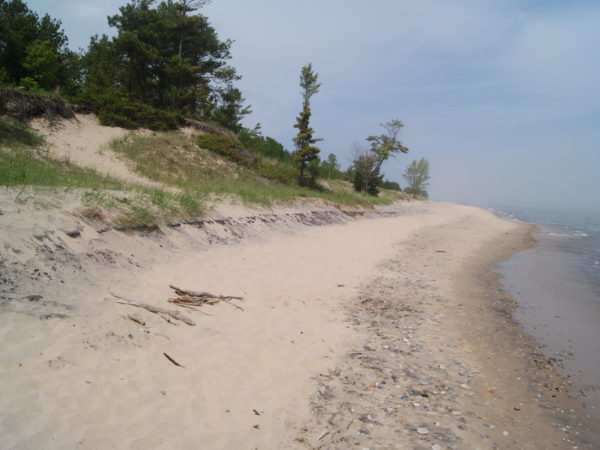
By Elinor Epperson, Michigan Public
The Great Lakes News Collaborative includes Bridge Michigan; Circle of Blue; Great Lakes Now at Detroit Public Television; Michigan Public, Michigan’s NPR News Leader; and who work together to bring audiences news and information about the impact of climate change, pollution, and aging infrastructure on the Great Lakes and drinking water. This independent journalism is supported by the Charles Stewart Mott Foundation. Find all the work HERE.
Of all the things I could step in while wandering the Shiawassee National Wildlife Refuge, vulture vomit was not on my list. My hosts, a team of scientists looking for native plant seeds, warned me to avoid it.
Elizabeth Haber is a lead botanist with Seeds of Success, a federal program that conserves and restores native flora. She and her team are combing through Michigan prairies, wetlands, and forests looking for native plant seeds.
“A lot of our days are just wandering around, using our intuition of where we think cool things might be,” she said.
Seeds of Success began in 2001 as a project of the Bureau of Land Management. It has been most prolific in the western U.S., where wildfires provide a constant need for habitat restoration. The program has collected almost a third of all native U.S. plant species, according to a 2019 paper analyzing its efficacy.
The Michigan team has over 100 species on its “wish list” for this year, Haber said. They’ve collected 12 so far. That’s because they need to plan extensively before they can start collecting, Haber said.
They’ve traveled to Shiawassee to scout for four species: swamp milkweed, hedge bindweed, sneezeweed and meadowsweet. They need to collect 10,000 seeds from each species, without decimating the local population.
“We need to scout [the location] to make sure that the population is indeed large enough for us to collect from,” she said. “So we do a lot of measurements.”
The plants have to be at the correct stage of their growth cycle, too. After examining a flowering plant, she showed me a handful of tiny black specks that looked like poppy seeds. They’re American germander or Teucrium canadense, a member of the mint family.
“The seeds right here are pretty mature. They’re looking pretty good,” Haber said. “They’re black and shiny, and they readily come off the stem. So that’s a signal to us that it might be a good thing to think about collecting soon.”

Elizabeth Haber holds a few seeds from a nearby American germander plant. The seeds are ready to collect and preserve. (Photo Credit: Elinor Epperson)
Meredith Holm, a wildlife biologist with the U.S. Fish and Wildlife Service, said native seeds are “foundational” to healthy, functioning ecosystems.
“We need the right seed in the right place at the right time,” she said, echoing the National Seed Strategy. Holm is based in Lansing, where she works with Haber’s team to plan trips to parks and private preserves across the state.
Native species face a gauntlet of challenges, from climate change to human activity. A recent study found that non-native species spread much faster than native species.
Native ecosystems can’t keep up and aren’t able to recover. Preserving native diversity reduces extinction rates and stabilizes ecosystems in crisis.
During our hike, Haber and her team point out a prairie teeming with the invasive reed canary grass.
“That stuff’s bad news,” Haber said. On the other side of the trail, closer to the water, is prairie cordgrass, a native species competing with the invasive grass. Haber marked the cordgrass on a GPS, so they can find it when they come back to collect its seeds.

Jenna Nutter, a field technician with Seeds of Success, examines a stalk of reed canary grass in Shiawassee National Wildlife Refuge. The invasive prairie grass is common in Michigan. (Photo Credit: Elinor Epperson)
Haber’s team is the first to focus exclusively on Michigan. The project is a joint effort between the Fish and Wildlife Service and the Chicago Botanic Garden, which oversees collection and storage of seeds from 15 states in the Midwest.
“We’re just getting started in the east,” Holm said. Research teams are also collecting seeds in Ohio, Illinois, Wisconsin and Minnesota.
Kayri Havens, vice president of science at the Chicago Botanic Garden, said that’s thanks in part to an influx of federal funding.
“That’s allowed us to scale up in areas that we hadn’t been working in prior to the passage of those bills,” Havens said. The 2021 Inflation Reduction Act has provided the lion’s share of federal funding, with $20 billion for restoring land across the country.
Collecting seeds is just the beginning.
“Seeds offer options for restoration in the future,” Havens said. After collection, seeds are cleaned and stored. Some seeds contribute to research at the botanic gardens, while others are propagated for habitat restoration. The collection project is the first of many steps towards restoration and resiliency.
In Michigan and the Midwest, that includes wetlands and former farmland. Lands damaged by flooding or invasive species need restoration to recover.
Urban areas need restoration, too. Vacant lots are a breeding ground for invasives if left unchecked. In addition to stormwater management and offsetting carbonization, green rooftops can also provide their own ecosystem for native plants and pollinators, said Havens.
“There’s not a place on the planet that doesn’t need restoration,” she said. “It’s always been an issue of capacity to do the work. And so we’re helping build that capacity in the Midwest.”
The trip to Shiawassee was a success, said Haber, the botanist with Seeds of Success. The team found three of the four species they were looking for. They also identified a few species that were good candidates for collection.
They will return to the wildlife refuge in the coming weeks. Hopefully, there will be less vulture vomit in their path.
Catch more news at Great Lakes Now:
Green infrastructure job trainings aim to support growing field
Remote-controlled robots cleaning up small Michigan beaches
Featured image: Elizabeth Haber, a botanist with Seeds of Success, looks for native plants in Shiawassee National Wildlife Refuge near Saginaw. (Photo Credit: Elinor Epperson)




